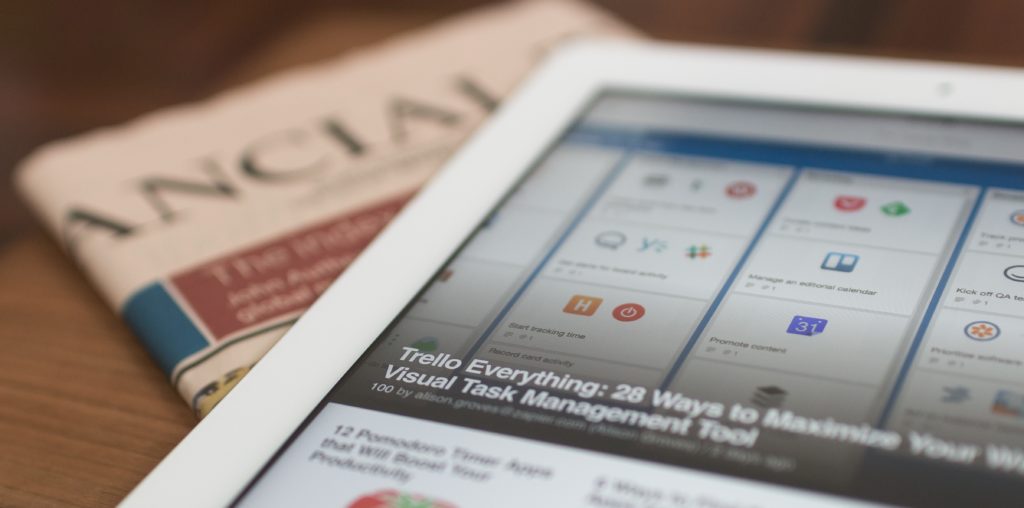Whether you’re wandering down the fruit and veg aisle in the supermarket or choosing the next book to read, chances are you’re looking for something that’s good quality and worth spending money on. With apples, it’s easy to spot the ones with bruises and with books… well, you shouldn’t judge one by its cover but you can usually get a good sense from the first page.
You know what to look for and how to distinguish the good from the bad in a lot of instances, but it isn’t always that simple when it comes to figuring out whether an online publication is decent.

The internet is awash with thousands of online magazines and news sites. You’ve probably even heard that print is dead as people turn to their tablets to consume the ever-changing news cycle. As a consumer, you probably have a favourite place to get your news, read up on a bit of celebrity gossip or catch up on your niche subject of choice. As a business person or PR however, you have to make these decisions on behalf of a business. Is this news site a good place for your coverage? Should we spend the time pitching a feature to them?
If you’re not sure what to look out for, we’ve put together some handy hints to help you spot a quality online publication. Not only will this help you focus where you share your news, but it will also give you credibility and ensure the best audience for your message is reached.
Check the Domain Authority

A website’s DA, or Domain Authority, is a great way to start if you’re busy going from website to website, researching new potential outlets for your news stories and articles.
DA is a search engine ranking score that was developed by Moz, which offers SEO insights and tools from its team of experts. According to Moz, DA predicts how well a website will rank on search engine results page. It ranges from one to 100, and the higher the score, the greater the ability to rank.
DA rankings are based on factors such as:
- Linking root domains
- Number of total links
The higher the DA, the better. Moz states that DA should be used as a comparative metric, but it’s indicative of what sites have stronger link profiles. Sites like Twitter, Facebook and even Gmail have strong DAs and news sites like Metro and The Guardian are also pretty high.
You’ll want to focus on getting your articles on sites with DAs of at least 15, and anything less than that are probably going to be relatively new or not very established as news outlets.
Are they asking for money?

Sometimes, representatives from online media outlets will give you a call or send you an email off the back of a press release asking if you’d be interested in paying for the story to be published on their site.
This can be justified and there’s nothing wrong with saying yes, but if they’re asking for thousands of pounds for something obscure on a website that doesn’t look very trustworthy – or worse, doesn’t even come up on the first page of Google when you search for it – then it probably isn’t going to be worth your time.
It’s good to keep in mind that quite a few digital publications have changed their business model over the years and do charge businesses to share their articles, as an alternative to (or to subsidise) having ads on their pages. The main thing to keep in mind is will the return match the investment? Is anyone even reading this or is the audience made up solely of other businesses checking if their £600 + VAT article has been published yet? If it’s a national media outlet or is a trade publication that you’re really keen to get into, a paywall shouldn’t stop you; otherwise, it’s worth asking the salesperson to email over:
- Price per article
- What their DA is
- Audience type to ensure it’s your target
- The audience reach
Just be cautious of those content cowboys that are filling their sites and publications with nothing but paid for articles.
Quantity over quality content

Most PRs or in-house teams will have their own method of distributing their press releases. From sending personal emails to a select few journalists that you have rapport with to distributing via a news wire and everything in between, it’s great that we have some many options available to us. What you choose depends on what works best for you, but if you’re wanting to ensure you’re landing in quality publications, it’s probably best to ensure that you’re in charge of the contacts that it goes to.
Using a news wire can often result in your release going AWOL, and before you know it, you have hundreds of coverage results. Great! You might think. Until you delve a little deeper and realise that the kind of sites it has been published on simply churn out release after release from news wires. Trust us when we say nobody is reading those, so your target audience certainly isn’t.
These kinds of sites exist just to keep a rolling cycle of news and have zero filter of standard of quality when it comes to the content that they host. It’s just hundreds and hundreds of stories from across the world and within all industries. The saying goes that all PR is good PR, but this is sort of… non-PR. PR in the void, if you will.
Is it well-known?

Often, reputation does the talking when it comes to the media. If you’re in a particularly large industry and a journalist from an outlet you’ve never heard of approaches you, then it’s probably worth doing a little more digging.
They might be a brand new site, which could be an exciting opportunity if they look like they know what they’re doing, or a more established outlet. This is when your supermarket browsing prowess comes in handy. You can just spot quality. The website is slick; they give plenty of information about themselves; there’s a media pack available to give you all the information you need about their advertising model, who you can speak to about editorial and importantly, contacts for their reporters and advertisers.
It should already have some content on there too. More established sites will have plenty of quality articles that use good quality images, cite their sources and are relevant to the audience and true to the kind of media that is. Maybe it’s aimed at the hospitality industry, theatre goers, restaurant enthusiasts, and so on. The content should reflect that, and it’s even better if you’re seeing content from businesses you know and even better, your rivals. That’s when you know you need to get your content on there too.
If you can see through a poorly designed website that offers little to no information about who’s behind it, and has hardly any content or spam or automated content, it’s best to give it a miss.
If you’re finding it difficult to navigate the digital age and spot a strong coverage opportunity, then that’s exactly what we’re here for. Our team is well-versed in what makes for good coverage and the boxes a quality news outlet should tick.
Get in touch today to find out how we can help get your message in front of the right people, in the right places.



